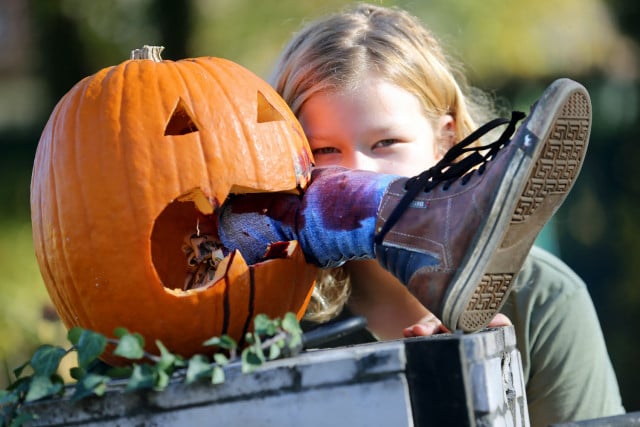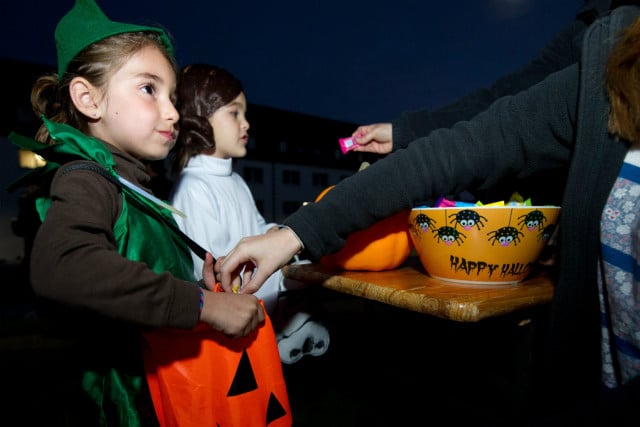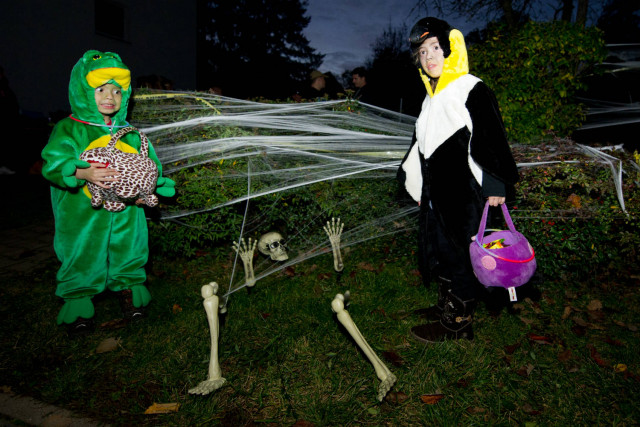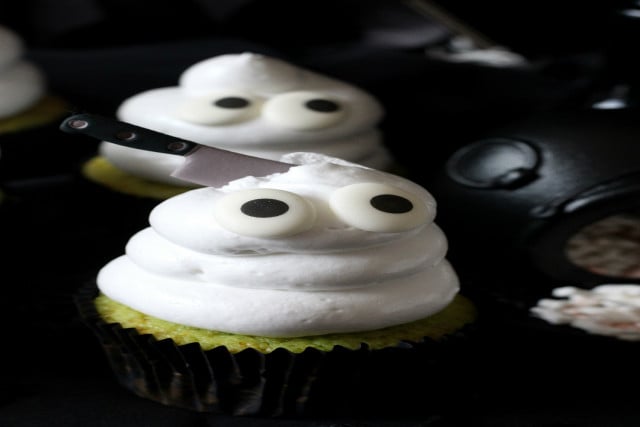How Halloween is celebrated in Germany

It's not just a North American tradition - Halloween is also celebrated in Germany. From the phrases you need to local 'trick-or-treating', a German-American shares what the holiday is like in Berlin.
Spooky cobwebs coated the windows of my family’s home and candle-lit carved pumpkins glowed in the shadows.
This scene might resemble a house in the US around Halloween, but it actually took place where I grew up in Berlin.
When I used to go trick-or-treating in Schmargendorf, in the Berlin neighbourhood of Wilmersdorf, I would dress up and have my mom put make-up on my face shortly before it became dark.
After that I would head out for one or two hours with my mom or dad, who were usually dressed up as well. We knew which places to go to and which houses to avoid in order to stock up on candy.

A creative (and gruesome) pumpkin carving in Brandenburg for Halloween 2018. Photo: DPA
How Halloween spread to Germany
Halloween originates from the old Celtic festival of Samhain.
In the evening from October 31st to November 1st, the dead supposedly rose from their graves and attempted to repossess the living.
In order to avoid this, the Celts tried to scare them away or disguise themselves in order to remain unnoticed. This traditional holiday eventually turned into a commercial celebration in America and is nowadays renown worldwide.
The holiday came to Germany at the end of the 90s and is a popular event today. In Germany, the younger generation such as preschoolers and elementary schoolers participate actively.
READ ALSO: The rise and rise of the pumpkin in Germany
Kindergardens, schools and after school care-clubs often join in this event by hosting small parties in class, accompanied by music, snacks and costume-competitions.
For the most part, Halloween costumes are spooky or gruesome, such as a witch or ghost. Children will not usually dress up as a princess for example, because in Germany Halloween is considered a spooky event and “Fasching” (Carnival) is reserved for non-Halloween costumes that are more colourful and joyful - such as clowns. In southern Germany, however, these costumes can take on a scarier appearance.
READ ALSO: Fasching: Tracing the roots of South Germany's 'Dark Carnival'
How do you ‘trick-or-treat’ in Germany?

Two children trick-or-treating for candy at an American military base in Stuttgart. Photo DPA
You can either make your own Halloween costumes or buy them in dozens of stores ranging from simple supermarkets to actual costumes shops that sell whole costumes or individual items such as coloured contact lenses or elf ears.
Trick-or-treating, or “Um die Häuser ziehen (Going around the houses)" as the Germans call it, usually takes place in your own neighbourhood with the same intentions as in the US: collecting candy or playing pranks (Streiche spielen).
The German version of the classic Halloween phrase trick-or-treat is “Süßes oder Saures” (Sweets or sours) or, differently phrased, “Süßes sonst gibt's Saures” "Give me sweets or there will be sour things."
But some children learn longer phrases and “perform” them in order to earn candy:
“Spinnenfuß und Krötenbein, wir sind viele Geisterlein!"
"Wir haben leere Taschen und wollen was zum Naschen!"
"Spider foot and frog leg, we are many ghosts! We have empty bags and want something to snack”.
These phrases usually rhyme and are a fun thing to recite!
A special scary spot

Trick-or-treaters enjoying a well-decorated Halloween yard in Stuttgart. Photo DPA
In Berlin, it has come to some Germans' attention that the American sector near Oskar-Helene-Heim is a great place to collect the “good” American candy. These streets are often decorated incredibly scary and the people pass out tons of candy.
In other German neighbourhoods, as I can only speak from my experience, there are only a few houses that actively participate in decorating.
It should also be mentioned, that it is more difficult to decorate visibly from the outside when you live in an apartment story building. Also it's a bit unclear at the moment how widespread visiting houses will be since we're still in the pandemic.
But many households carve scary or fun pumpkins and set them outside for everyone to see. This is a good indicator for from which homes you will receive candy and from which not. If you do not wish to participate in Halloween you should turn your lights out; only then you will you not be bothered by the doorbell.
There are fewer Halloween parties than in the US where you dress up and eat gruesome foods, but they are becoming increasingly more popular, especially through Youtube influencers.
They post dozens of videos on how to throw a great Halloween party or how to make a last minute costume which sparks interests in especially young adults.
However, many teenagers and adults do not skip this event but visit parties in clubs, where they dress up, drink and dance.
I never learned a longer phrase to recite but stuck with trick-or-treat or Süßes sonst gibts Saures, because that would do the trick as well. When walking through the streets, we would pass usually younger children with their parents, children in smaller groups, or teenaged boys with Halloween masks on who were only in it for the candy.
A sweet reward

Fun ghost cupcakes for a Halloween dessert. Photo DPA
When I was growing up many people - I could tell - bought their costumes. I, thanks to my mom, had a homemade costume every year.
Most people who had their lights on were prepared to hand out candy and excited to see the spooky costumes. Others would open the door, seemingly haven forgotten about Halloween, and hand out random sweets or fruit that did not excite me very much. (We would try to remember that place and avoid it the next year).
Others were just annoyed by this event.
Despite those people, it was a fun evening every year. I always returned home with more candy then I could eat. There were times where it literally lasted until Easter!
When I grew older I had the feeling that less people went trick-or-treating and less people were participating in this event, which could be because the neighbourhood was growing older or because people went to areas where there was more candy to collect.
Nowadays, I try to convince my friends to throw a Halloween party with me. Initially, they are never thrilled by the idea because they are not convinced by the dressing up part, but usually I can persuade them by mentioning the Halloween-y food and drinks.
Comments
See Also
Spooky cobwebs coated the windows of my family’s home and candle-lit carved pumpkins glowed in the shadows.
This scene might resemble a house in the US around Halloween, but it actually took place where I grew up in Berlin.
When I used to go trick-or-treating in Schmargendorf, in the Berlin neighbourhood of Wilmersdorf, I would dress up and have my mom put make-up on my face shortly before it became dark.
After that I would head out for one or two hours with my mom or dad, who were usually dressed up as well. We knew which places to go to and which houses to avoid in order to stock up on candy.

A creative (and gruesome) pumpkin carving in Brandenburg for Halloween 2018. Photo: DPA
How Halloween spread to Germany
Halloween originates from the old Celtic festival of Samhain.
In the evening from October 31st to November 1st, the dead supposedly rose from their graves and attempted to repossess the living.
In order to avoid this, the Celts tried to scare them away or disguise themselves in order to remain unnoticed. This traditional holiday eventually turned into a commercial celebration in America and is nowadays renown worldwide.
The holiday came to Germany at the end of the 90s and is a popular event today. In Germany, the younger generation such as preschoolers and elementary schoolers participate actively.
READ ALSO: The rise and rise of the pumpkin in Germany
Kindergardens, schools and after school care-clubs often join in this event by hosting small parties in class, accompanied by music, snacks and costume-competitions.
For the most part, Halloween costumes are spooky or gruesome, such as a witch or ghost. Children will not usually dress up as a princess for example, because in Germany Halloween is considered a spooky event and “Fasching” (Carnival) is reserved for non-Halloween costumes that are more colourful and joyful - such as clowns. In southern Germany, however, these costumes can take on a scarier appearance.
READ ALSO: Fasching: Tracing the roots of South Germany's 'Dark Carnival'
How do you ‘trick-or-treat’ in Germany?

Two children trick-or-treating for candy at an American military base in Stuttgart. Photo DPA
You can either make your own Halloween costumes or buy them in dozens of stores ranging from simple supermarkets to actual costumes shops that sell whole costumes or individual items such as coloured contact lenses or elf ears.
Trick-or-treating, or “Um die Häuser ziehen (Going around the houses)" as the Germans call it, usually takes place in your own neighbourhood with the same intentions as in the US: collecting candy or playing pranks (Streiche spielen).
The German version of the classic Halloween phrase trick-or-treat is “Süßes oder Saures” (Sweets or sours) or, differently phrased, “Süßes sonst gibt's Saures” "Give me sweets or there will be sour things."
But some children learn longer phrases and “perform” them in order to earn candy:
“Spinnenfuß und Krötenbein, wir sind viele Geisterlein!"
"Wir haben leere Taschen und wollen was zum Naschen!"
"Spider foot and frog leg, we are many ghosts! We have empty bags and want something to snack”.
These phrases usually rhyme and are a fun thing to recite!
A special scary spot

Trick-or-treaters enjoying a well-decorated Halloween yard in Stuttgart. Photo DPA
In Berlin, it has come to some Germans' attention that the American sector near Oskar-Helene-Heim is a great place to collect the “good” American candy. These streets are often decorated incredibly scary and the people pass out tons of candy.
In other German neighbourhoods, as I can only speak from my experience, there are only a few houses that actively participate in decorating.
It should also be mentioned, that it is more difficult to decorate visibly from the outside when you live in an apartment story building. Also it's a bit unclear at the moment how widespread visiting houses will be since we're still in the pandemic.
But many households carve scary or fun pumpkins and set them outside for everyone to see. This is a good indicator for from which homes you will receive candy and from which not. If you do not wish to participate in Halloween you should turn your lights out; only then you will you not be bothered by the doorbell.
There are fewer Halloween parties than in the US where you dress up and eat gruesome foods, but they are becoming increasingly more popular, especially through Youtube influencers.
They post dozens of videos on how to throw a great Halloween party or how to make a last minute costume which sparks interests in especially young adults.
However, many teenagers and adults do not skip this event but visit parties in clubs, where they dress up, drink and dance.
I never learned a longer phrase to recite but stuck with trick-or-treat or Süßes sonst gibts Saures, because that would do the trick as well. When walking through the streets, we would pass usually younger children with their parents, children in smaller groups, or teenaged boys with Halloween masks on who were only in it for the candy.
A sweet reward

Fun ghost cupcakes for a Halloween dessert. Photo DPA
When I was growing up many people - I could tell - bought their costumes. I, thanks to my mom, had a homemade costume every year.
Most people who had their lights on were prepared to hand out candy and excited to see the spooky costumes. Others would open the door, seemingly haven forgotten about Halloween, and hand out random sweets or fruit that did not excite me very much. (We would try to remember that place and avoid it the next year).
Others were just annoyed by this event.
Despite those people, it was a fun evening every year. I always returned home with more candy then I could eat. There were times where it literally lasted until Easter!
When I grew older I had the feeling that less people went trick-or-treating and less people were participating in this event, which could be because the neighbourhood was growing older or because people went to areas where there was more candy to collect.
Nowadays, I try to convince my friends to throw a Halloween party with me. Initially, they are never thrilled by the idea because they are not convinced by the dressing up part, but usually I can persuade them by mentioning the Halloween-y food and drinks.
Join the conversation in our comments section below. Share your own views and experience and if you have a question or suggestion for our journalists then email us at [email protected].
Please keep comments civil, constructive and on topic – and make sure to read our terms of use before getting involved.
Please log in here to leave a comment.